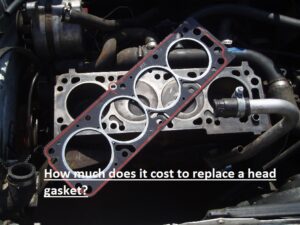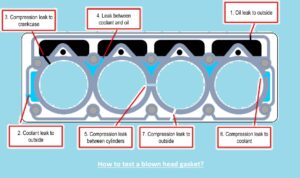The head gasket is the main component in your car’s engine or any other vehicle; it seals the engine block and cylinder to avoid mixing oil and coolant. If the head gasket is damaged for any reason, it causes different issues such as overheating the engine and oil leaking and also affects engine working performance.
The preparation expense for the head gasket involved mostly labor costs, and the components of the gasket are low cost. The replacement time normally taken for a head gasket is about 6 hours, and the cost is in the range of $1000 to $3000 or can be higher based on vehicles. Here we will cover the details for replacing the cost of the head gasket and related details.
What is a head gasket?
- The head gasket is a multi-layered gasket, and a thin layer exists between the engine block and the cylinder head. Its main function is to seal the engine and avoid the mixture of coolant, oil, and other mixing fluids.
- The head gasket also provides accurate engine compression, effectively providing smooth engine working.
- It is the main part of a car’s internal combustion engine and performs two main functions.
Sealing
- Head gaskets between the cylinder head and engine block provide separate paths for engine oil and coolant and also have combustion. The gasket prevents coolant and engine oil from leaking into cylinders.
Compression:
- The design of this component is thin and handles high combustion pressure used for car engines to work in an effective way.
- The safety of the head gasket is important for high engine efficiency, and an affected head gasket causes high damage.
Symptoms of a blown head gasket
Engine overheating
- There are abrupt temperature increases, coolant losses occur, and no leaks exist.
Exhaust smoke
- There is white smoke released in the exhaust pipe.
Discolored oil
- We can see a milky appearance on the dipstick since coolant contamination exists in the oil.
Bubbles in the radiator
- Visible air bubbles exist in the radiator during engine working.
External leaks
- • An oil leak in the engine exists around the head gasket.
engine performance
- • The engine has bad working performance, like low power and acceleration.
Sweet exhaust smell
- It causes head gasket damage and coolant burning in the engine.
Unusual sounds
- Coolant system produces hissing noises.
Does a blown head gasket mean it’s a sign of a new engine?
It is based on a fault in a blown head gasket and driving without repairing the head gasket. Some faults occur when the head gasket is blown and are explained.
Damaged Cylinder Head
- The damaged cylinder head comes with cracks, tunneling, or warping. The cracked cylinder head is a boat anchor. The cylinder head, having thinned, can be repaired, but mostly not.
- • A warped cylinder comes with it to repair it if it is not highly warped. We can say the damaged cylinder head needed a new engine.
Damaged Engine Block
- The blown head gasket repair is not possible if the engine block is affected, but it takes more damage as compared to the cylinder due to the materials used for the engine block design. It is based on the surface area of the engine block damaged for defining that head gasket repair can be done.
Bearing Error
- If head gasket damage occurs, high heat is produced in the engine and results in damage to the bearing. If there is oil and it has an appearance like watery oil, it is not possible to repair that is also impossible to repair the head gasket.
How Much Does It Cost to Repair a Head Gasket?
- The cost for head gasket repair is between $1000 and $3000 or can be higher based on damage. It is not the gasket cost but the time taken for repairing the gasket. If it is found that the head gasket is possible, it is not a fact that a new gasket.
- There is a need to remove the engine or the upper half of the engine. Different parts of the engine need to be disconnected from the gasket. The older gasket is removed, and a new connection is made.
How to test a blown head gasket?
Remove the oil cap.
- Check that if there is coolant leaked into oil through checking the oil filler cover. For checking the inside, take time for the engine to cool after running and remove the cap. If there is any milky brown material, that means coolant is being made.
- It is not a proper method for defining that you have blown a head gasket; it does not mean there is any fault.
Monitor Fluid in Combustion Chamber
- • The head gasket’s job is to provide coolant between the engine block and cylinder head. If it does not work well, there is a chance that it leaks combustion chamber.
- Check it by removing spark plugs and operating the AC and crank fan and starting the engine. Check the complete spark plug, and if there is any fluid in any hole, that means a blown head gasket.
Radiator Checking
- The other sign for a damaged head gasket is releasing exhaust gasses out of the tailpipe. So exhaust gases can enter the cooling system.
- Check exhaust gases by checking bubbles after removing the radiator cap when the engine is in cold conditions.
- It is good to check when the engine is in cold conditions. When the engine is hot can cause a high-pressure burst.
- The other process for checking the blown head gasket is difficult; that is, use a pressure test on the cylinder.
Which is better, to replace the head gasket or the engine?
- If nothing is damaged, then thest of these two is to replace the head gasket for a low-cost option. Since replacing a new engine is a high-cost option,
Is it possible to drive with a blown head gasket?
- If there is a leaking head gasket, it is good to not drive the car and move to the mechanic. Based on leaking, define how much you can drive.
- Not drive or not can drive before repairing the head gasket.
How to reduce head gasket repair cost?
Routine maintenance
- Regular maintenance is the main factor for reducing the cost of repairing the head gasket, which helps to find minor faults at the start and avoid high damage.
Proactive repairs
- Solve low leaks instantly to avoid small problems from converting to larger issues for head gasket problems.
Solve warning signs.
- If there is any warning, solve the issue to save the head gasket from error.
driving guidelines
- Drive in a responsible way to avoid any fault in the engine and head gasket.
quality coolant
- The use of high-quality coolant is the main method for safety for the head gasket and to avoid the car engine getting corroded.
Check coolant levels.
- Check engine coolant levels and check for leaks to avoid overheating and head gasket effects.
Warm up and cool down the engine.
- Do a proper engine warm-up before driving. Also, cool it down before running off to reduce thermal stress on the head gasket.
Overheating
- Solve cooling issues and avoid high temperatures for long time to avoid head gasket and engine issues generally.
FAQs
Is it good to fix a blown head gasket?
- The repairing of the head gasket is work for minor damage, but high issues need to replace it for longer work. The replacement of the head gasket saves the vehicle from high damage.
Is replacing a head gasket a difficult task?
- The replacement of the head gasket is difficult work that comes with engine disassembly, cleaning, and reassembly. It needed a skilled person and also proper tools. A skilled mechanical person can do this job.
What is the engine’s working life after a head gasket replacement?
- The working life of an engine having a new head gasket is based on the working of the vehicle, driving conditions, and engine damage. With the use of accurate care and safety measures, functionality increases.
Does a head gasket sealer work?
- Head gasket sealers provide a short-term solution for minor leaks, but they are not a long-term solution. So complete replacement is required for longer work.
What are the first signs of a blown head gasket?
- The first and basic sign of a blown head gasket is engine overheating. If there is head gasket damage, it can help coolant to leak into the combustion chamber.
What is the cheapest way to fix a blown head gasket?
- The blown head gasket fixing is easy, like dumping a bottle of sealant in the radiator. The seal made in
How long will a car last after head gasket replacement?
- 100,000 miles
How long can a car go without a head gasket?
- If the gasket is damaged, it can cause serious damage to the car, so it is good to check for warning signs and fix it. Based on the leak, car work is not more than one month with a blown head gasket.
Can you replace the head gasket without removing the engine?
- You can replace a blown head gasket without removing the complete engine. That process is disassembly of the upper part of the engine for accessing the gasket. That process is minimally invasive and reduces time and cost.

